Art reference poses are a crucial tool for artists striving to create lifelike and accurate depictions of the human form. These visual aids provide valuable guidance on the proportions, anatomy, and posture of figures in various positions, serving as a foundation for both learning and refining artistic skills. By using art reference poses, artists can effectively translate the three-dimensional world onto a two-dimensional canvas, capturing the complexity of human movement and form in their work.

The importance of sourcing diverse and high-quality pose references cannot be understated. A well-constructed reference can greatly enhance the artist’s ability to practice and perfect their technique. It also ensures a greater variety of figures is represented in their art, promoting inclusivity and realism that resonates with a wider audience.


From traditional methods like live models and photographs to digital resources such as 3D modeling software and interactive pose websites, artists now have an array of options to choose from for their pose reference needs.
Key Takeaways
- Art reference poses assist artists in creating accurate and dynamic representations of the human form.
- Quality and diversity in reference materials are vital for artists to enhance practice and inclusivity in their work.
- A range of traditional to digital tools are available for sourcing and creating effective art references.
Understanding Art Reference Poses

Art reference poses are essential tools for artists to capture the correct form and dynamics of the human body in their drawings. They facilitate a deeper understanding of anatomy, movement, and realistic depictions in art.
Importance of Pose References
Utilizing pose references is crucial for creating accurate and believable artwork. They guide artists in understanding how light and shadow interact with the body and how different positions affect perspective. This understanding helps in composing drawings that are both dynamic and precise.
- Accuracy: Using references ensures proportions and angles are faithfully represented.
- Dynamics: References can capture transient poses the artist wouldn’t be able to visualize otherwise.
Anatomy and Structure
An artist’s grasp of human anatomy is fortified by studying art reference poses. These references are invaluable for comprehending the underlying skeletal structure and how muscles depict movement and tension across different poses.
- Skeletal Understanding: Helps artists recognize which bone structures are prominent in various positions.
- Musculature: High-quality references show how muscles stretch, contract, and appear on the surface of the skin.
Gender Variations in Art Reference Poses
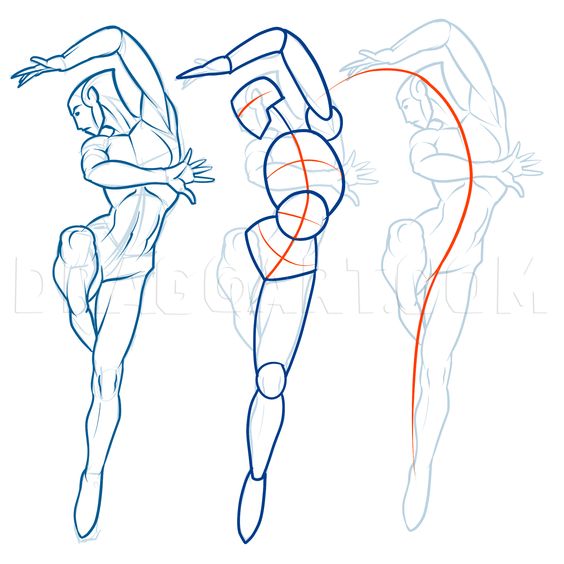

Gender differences often necessitate tailored art reference poses. Artists must acknowledge the distinct anatomy and body structure variations that gender introduces to accurately represent their subjects.
- Male Figures: Typically showcase broader shoulders and more angular musculature.
- Female Figures: Often depict softer curves and nuances in body shapes that are specific to female anatomy.
Reference poses divided by gender help artists achieve realistic and representative depictions of their subjects, respecting the differences in body types.
Sourcing Pose References

When creating art, finding the right pose reference is crucial for accuracy and realism. Consider various sources, including free online resources, dedicated pose reference websites, and ensure an understanding of copyright policies.
Free Online Resources
A wide array of free online resources offer art pose references which cater to diverse artistic needs. For example, Quickposes provides a large library of dynamic poses to practice drawing skills. Similarly, SketchDaily, through its subreddit, presents daily pose challenges and other resources that can supplement an artist’s reference library.
- Quickposes: Dynamic poses.
- SketchDaily: Daily challenges.
Pose Reference Websites
There are dedicated websites that specialize in providing high-quality pose references, often for a fee but sometimes for free. Croquis Cafe is an online figure drawing class that mimics the experience of a traditional figure drawing session. Another notable resource is Adorkastock, which offers an extensive selection of free and purchasable poses tailored for artists.
- Croquis Cafe: Online figure drawing.
- Adorkastock: Extensive pose selection.
Copyrighted Materials and Usage Policy
When using pose references, it’s critical to comply with the usage policy of copyrighted materials. The usage policy dictates how an artist can use the pose references in their work, whether for personal practice, commercial use, or educational purposes. Ignorance of these policies could lead to legal complications, so artists should thoroughly review and adhere to them.
- Copyrighted Materials: Follow usage policies.
- Usage Policy: Dictates permitted uses.
Pose Reference for Practice

Using pose references is crucial for artists to enhance their drawing skills through practice. They can employ various methods such as gesture drawing and figure drawing, with each offering different benefits and focusing on specific aspects of skill development.
Gesture Drawing and Timed Sessions
Artists practicing gesture drawing aim to capture the essence of a pose within a short time frame. It helps in developing a keen eye for the fluidity and motion within a figure. Timed sessions, typically ranging from one to five minutes, compel artists to focus on the overall form rather than intricate details. This practice sharpens one’s ability to swiftly identify and translate movements and poses:
- 1 Minute: Quick sketch to grasp the basic action line.
- 3 Minutes: Adds major shapes and simple forms to the action line.
- 5 Minutes: Further refines the pose, incorporating main muscle groups.
Figure Drawing Skills Enhancement
Figure drawing takes a more detailed approach. Artists spend extended periods on a single pose, allowing for a deep understanding of human anatomy and proportions. This methodical practice is essential for artists looking to refine their skills in rendering realistic figures:
- Anatomy Recognition: Identify and depict individual body parts.
- Proportion Mastery: Ensure accurate sizing and spacing of figure elements.
- Longer Poses: Encourage thorough observation and portrayal of subtle details.
Through these practices, both gesture and figure drawing, artists enhance their proficiency and develop the skill set necessary for proficiently executing various poses in their work.
Diversity in Pose References


In the realm of artistic portrayal, diversity in pose references is instrumental for capturing the myriad human experiences through various stages of life and attire.
Age and Body Diversity
Artists seek to represent a broad spectrum of age groups, ensuring that each life stage is depicted with authenticity. For children, they often highlight the buoyant and dynamic energy that characterizes youth. Teenagers are presented with a blend of youthful features and the emergence of maturity. Adults are the most varied group, showcasing the full breadth of human body forms and life expressions. The elderly are rendered with attributes that reflect a lifetime of experiences, with an emphasis on dignity and the grace of age.
- Youth: Dynamic energy, playful poses.
- Teenagers: Transitional features, a mix of awkwardness and poise.
- Adults:
- Lean and athletic: Agile, powerful stances.
- Fuller figures: Strong, grounded poses.
- Elderly: Weathered textures, respectful portrayals.
Clothing and Draped Figures


Art references for clothed figures assist artists in understanding how different materials interact with the body and how clothing can signify character, status, or era. Nude references are crucial for learning the nuances of anatomical structure and the interplay of light and shadow on the human form.
Clothed:
- Casual Wear:
- Soft folds, loose fit.
- Casual stances, relaxed.
- Formal Attire:
- Crisp lines, tailored fit.
- Poised, structured poses.
Nude:
- Highlights the underlying structure of the body.
- Allows for the study of muscle tension, relaxation, and posture.
When incorporating clothing, attention is paid to how different fabrics drape over various body types and the way movement affects the silhouette.
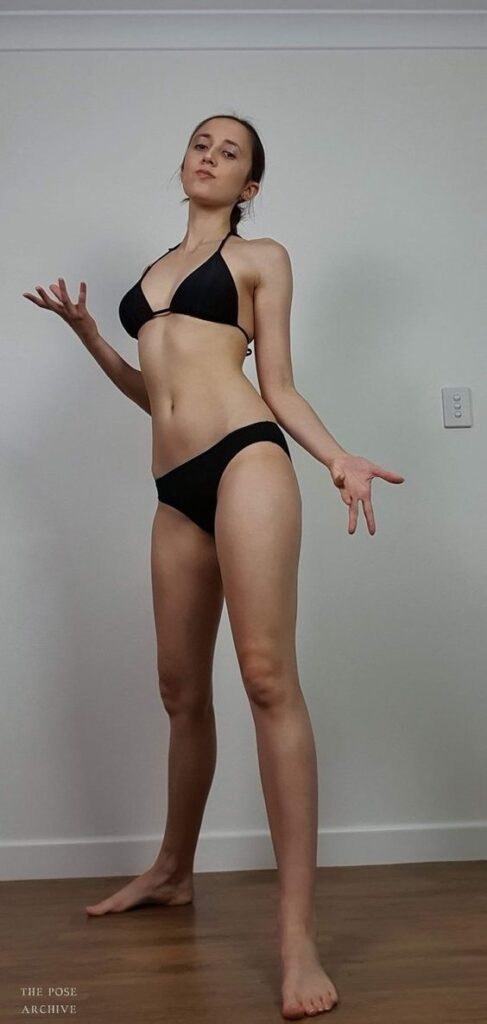

This attentive observation is integral for artists in rendering realistic clothing.
- Silk: Light, flowing drapes with gentle curves.
- Denim: Stiff, rugged folds with sharper angles.
- Linen: Crisp texture, moderate flexibility in draping.
Technical Aspects of Pose References
In art, mastering the technical aspects of pose references is crucial for developing accurate, realistic representations. Lighting, perspective, and anatomical correctness play significant roles in conveying the depth and texture of the subject.
Lighting and Shadow


When setting up lighting for a pose reference, one must consider the direction, intensity, and color of the light source. These factors affect the shadow and shading on the subject, which in turn reveal the form’s volume and placement in space. Artists typically use a combination of:
- Key light: The primary source of light, often creating the most distinct shadows.
- Fill light: A softer light reducing the harshness of shadows cast by the key light.
- Backlight: Providing definition and subtle highlights around the subject’s edges.
Creators should observe how light interacts with different materials, affecting texture and depth.
Perspective and Foreshortening

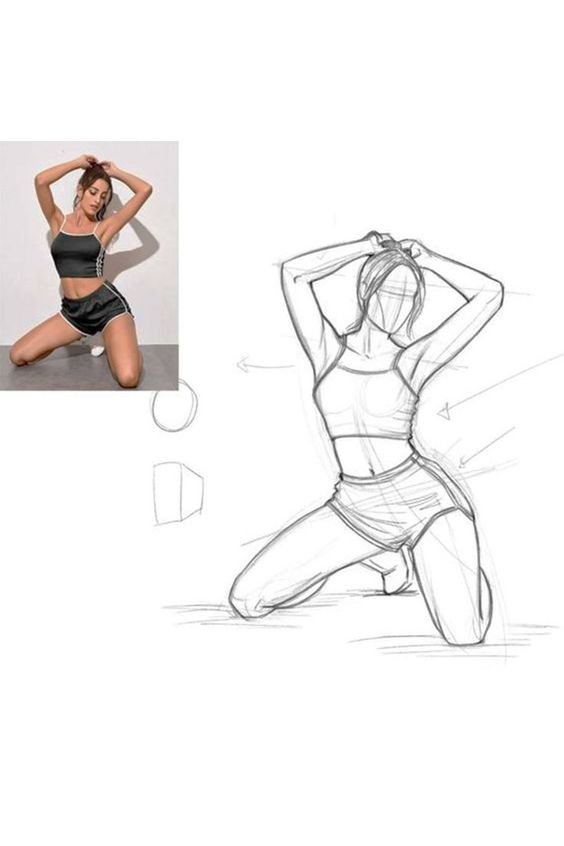
Perspective in pose references governs how objects appear smaller as they recede in space, a critical element in creating a sense of three-dimensionality. Foreshortening is a technique used to represent an object or limb as shorter than its actual length, due to its angle toward the viewer. They should consider:
- Eye level: The horizontal line where the sightline of the viewer is established.
- Vanishing points: Positions on the horizon line where parallel lines seem to converge.
Understanding these concepts helps in depicting the pose correctly and enhances the illusion of depth.
Proportions and Anatomy Details


Pose references must respect correct proportions to ensure the figure’s believability. This means paying attention to:
- Relative sizes: The size of body parts in relation to each other.
- Consistency: The maintenance of proportion throughout different poses.
Furthermore, capturing anatomical details like muscle structure and bone landmarks is essential for portraying a realistic human figure. Artists must be aware of the underlying structure of the body to accurately render the surface forms and how they behave in different poses.
Art Reference for Different Genres


Artists often seek reference material specific to the genre they are working on to ensure accuracy and detail in their creations. The right reference can mean the difference between a believable scene and one that doesn’t quite hit the mark.
Character and Comic Art Reference


Character and comic art requires dynamic references that capture movement and form. Comic artists often use pose references to ensure that their characters in action are anatomically convincing. When designing characters, they might reference photos or models demonstrating different postures that are pertinent to the character’s personality and the story’s tone.
- Movement: Action shots, fight scenes, dynamic jumps
- Form: Body types, clothing folds, muscle structure
Landscape and Urban Art Reference
Capturing the essence of a setting is vital in both landscape and urban art. Artists looking to illustrate natural sceneries will benefit from high-quality landscape reference photos that show varied lighting and weather conditions. Similarly, urban art references should detail architectural styles, street layouts, and the interaction of light with buildings.
- Natural Elements: Trees, rivers, mountains
- Urban Details: Building facades, street corners, public spaces
Portrait and Expression References


Portraiture hinges on conveying the subject’s personality and emotions, often using portrait reference photos. When depicting emotions, expression photos are invaluable for illustrating the subtleties of human emotion. These references are crucial for artists to accurately render facial features and emotional nuances across different age groups, lighting set-ups, and cultural backgrounds.
- Features: Eye shapes, nose contours, lip forms
- Expressions: Joy, sorrow, anger, surprise
Advanced Reference Techniques

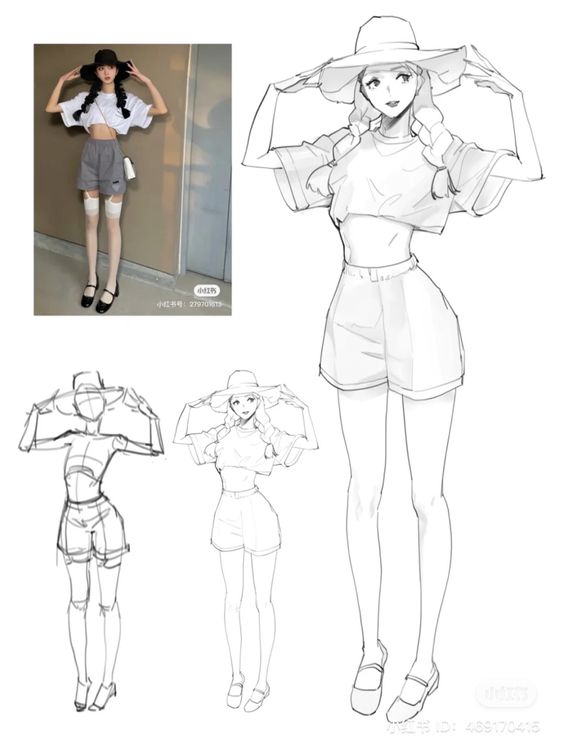
In the realm of art, capturing the essence of movement and dynamic tension significantly enhances the portrayal of subjects. Advanced reference techniques enable artists to achieve more lifelike and energetic depictions.
Dynamic and Action Poses


Dynamic and action poses capture movement, exhibiting a subject in the midst of an activity. Artists focus on the flow of the body, allowing the pose to convey a sense of motion. Key aspects include:
- Body Rotation: The twisting of the body to suggest momentum.
- Weight Distribution: Shifting of weight implies direction and force.
- Muscle Tension: Highlighting active muscles suggests energy.
| Action Element | Description |
|---|---|
| Jumping | Body arched, limbs in directional flow |
| Running | Forward lean, one foot off the ground |
| Throwing | Rear arm coiled, opposite leg braced for support |
Artists should study sequences of motion to understand the fluid transitions between poses.
Contrapposto and Non-Static Poses


Contrapposto and non-static poses defy rigid symmetry, presenting the subject in a more relaxed, naturalistic stance. These poses replicate real-life stances humans take as they shift their weight.
- Contrapposto Position: This stance involves a subtle twist of the torso with a shift in weight predominantly on one leg, creating a sense of balance and ease.
- Fluidity: Non-static poses appear more lifelike and less forced, capturing the natural curves of the body.
| Pose Detail | Importance |
|---|---|
| Relaxed Shoulders | Implies a casual, at-ease posture |
| Bent Limbs | Indicates natural, unforced movement |
| S-Curve Spine | Demonstrates the natural alignment of the body |
The contrapposto position is integral for depicting a person in a relaxed, poised state, making the figure seem grounded and composed. Artists benefit from observing these poses in everyday life to appreciate their nuances.
Interactive and Alternative References
Artists seeking to enhance the realism and dynamism of their work often turn to interactive and alternative methods for creating art reference poses.
Using 3D Models and Props
3D models have become an invaluable resource for artists. These digital entities offer artists the ability to manipulate aspects such as lighting, angle, and position, providing a highly flexible reference that can aid in creating more accurate and dynamic poses. For instance, software such as Blender and ZBrush is widely used to craft and customize models to precise specifications.
- Pros:
- Customizability: Alter body positions, camera angles, and lighting.
- Reusability: Save and modify 3D models for future projects.
- Cons:
- Requires learning software-specific skills.
- May need significant computer resources.
Props, whether physical or digital, add context and realism to poses. They help in establishing the weight and interaction of the model with their surroundings. Commonly used props include chairs, weapons, or technological devices.
- Benefits of incorporating props:
- Encourages realistic physical interaction.
- Enhances the believability of the pose.
Incorporating Vegetation and Animals


Adding vegetation into art references imparts a layer of authenticity to outdoor scenes. It helps artists understand how elements such as wind or weight might affect natural surroundings in relation to the model. Real branches or leaves can be used, or digital proxies can be created to simulate the environment.
- How vegetation improves art references:
- Adds complexity to the environment.
- Influences pose and composition based on natural interactions.
Animals present dynamic and organic reference challenges. Whether using photo references, live animals, or digital models, they contribute to the artwork’s vitality. For example, the observation of how a bird might perch on a model’s arm informs both the poise of the model and the portrayal of the bird.
- Considerations when using animals in reference poses:
- Movement and behavior add spontaneous elements to poses.
- Interaction with the model can suggest narrative elements.
Creating and Sharing Art References

Creating and sharing art reference poses is a cornerstone in fostering a community of artists and improving individual artistry. The process involves the careful curation of a reference library and understanding the legalities of sharing these resources.
Developing Your Reference Library
Artists should actively build their reference library by collecting a wide range of art reference photos. It is beneficial to focus on diversity, capturing various body types, poses, and movements. One practical approach is to:
- Organize: Sort the photos into categories such as gesture, anatomy, perspective, and lighting.
- Quality over quantity: Ensure that each photo has clear lighting and is high-resolution to be genuinely useful.
- Continued expansion: Regularly add new photos to the library, which can involve personal photo shoots or purchasing from reputable sources.
Legal Considerations When Sharing
Selling or sharing art references demands strict adherence to copyright laws. Creators should:
- Check Copyright Status: Confirm that photos are either self-created or purchased from a source that allows redistribution.
- Understand Usage Policy: Study the usage policy of any stock photos used, as they may have restrictions on commercial use.
- Attribute Correctly: If the photos are not original, provide proper attribution according to the copyright holder’s requirements.
Feedback and Community Engagement

Engaging with the community and utilizing feedback are crucial for artists who incorporate reference poses into their work. This interaction enhances their skills and broadens their creative network.
Seeking and Providing Feedback
Artists often seek constructive criticism to improve their depiction of poses. By contacting fellow artists or using contact us forms on art platforms, they invite suggestions to refine their work. Conversely, seasoned artists provide feedback to aspirants, fostering a supportive environment. Here’s how to stay involved in feedback exchange:
- Join Online Forums: Participate in discussions and post your work for peer review.
- Social Media Groups: Share your art and ask for opinions from other illustrators.
By practicing these methods, artists stay connected and gain valuable insights into their work.
Connecting with Artists and Illustrators
Building a robust network is essential for artists who specialize in art reference poses. Below are some steps they take to connect:
- Attend Workshops and Events: They meet peers and learn new techniques.
- Collaborate: They engage in projects with other illustrators to broaden their exposure.
Illustrators thrive by fostering relationships that lead to growth and opportunities within the art community.
Technical Resources for Artists

The right tools can greatly enhance an artist’s ability to create and visualize art. This section focuses on the technical resources available to artists including sophisticated drawing tools and applications, as well as pose references specific to games and apps.
Drawing Tools and Applications
Artists have a wide variety of drawing tools at their disposal, ranging from traditional mediums to advanced digital applications. Notably, Procreate has become a staple for many artists working on iOS devices. It offers a comprehensive set of sketching, painting, and inking tools that cater to professional-level art creation. Artists can take advantage of its intuitive interface and extensive brush library, which is crucial for detailed artwork.
| Feature | Available in Procreate |
|---|---|
| Brush Library | Yes |
| Intuitive Interface | Yes |
| Compatibility with iOS | Yes |
Another notable application is Adobe Photoshop, renowned for its powerful image editing capabilities that extend to creating detailed digital paintings and drawings. Photoshop provides artists with an arsenal of tools and allows for intricate layer management, which is essential for complex compositions.
Pose Reference for Games and Apps


When creating character art for video games, artists can benefit from pose reference tools. These are designed to help visualize dynamic poses and understand the human anatomy in motion. DesignDoll is a notable mention, offering customizable models that can be posed virtually. It enables artists to create and experiment with different character postures, which can be directly applied to game design.
For mobile applications, tools like Magic Poser stand out. Available on multiple platforms including iOS, it allows artists to manipulate 3D models to find the perfect pose. This can be particularly advantageous for game artists who require precise character poses for in-game model sheets or promotional artwork.
DesignDoll
- Customizable models
- Virtual posing
Magic Poser
- Cross-platform compatibility
- 3D pose manipulation
Challenges and Solutions in Art Reference

In the realm of art, reference poses present unique hurdles for artists and illustrators. This section addresses typical obstacles encountered and offers practical solutions.
Overcoming Common Drawing Challenges
Distortion and Perspective: One prevalent issue artists face is capturing realistic poses without distortion. They can combat this by utilizing grid systems on their reference images, which aids in maintaining proportion and perspective. Additionally, studying and sketching from life or three-dimensional models can enhance their understanding of how bodies move and exist in space.
Light and Shadow: Achieving accurate lighting in drawings can be tricky. Artists should practice with basic geometric shapes, like spheres and cubes, to understand light’s interaction with surfaces. It is beneficial to work under consistent lighting when using reference images to grasp shadow behavior effectively.
Questions and Issues with Reference Photos
Authenticity of Pose: Artists often question the authenticity and practicality of poses within reference photos. To ensure they are working with viable poses, artists should look for references that show multiple angles of the same pose. They might also consider using a mix of photo references and live models to verify the naturalness of poses.
Copyright Considerations: The legality of using certain reference images can be a concern. Artists need to check if images are labeled for reuse and modification or consider purchasing stock photos with clear usage rights. Creating their own reference photos is also an effective solution to this problem, as it gives them complete creative control.
Final Thoughts

In this section, the reader is provided with guidance on merging the acquired knowledge of art reference poses with their creative practice.
Synthesis and Applying Knowledge
Artists often rely on a rich synthesis of observation and imagination. When artists search for reference poses, they harness a collection of visuals to inform their work. By studying these references, they acquire a deeper understanding of human anatomy and movement.
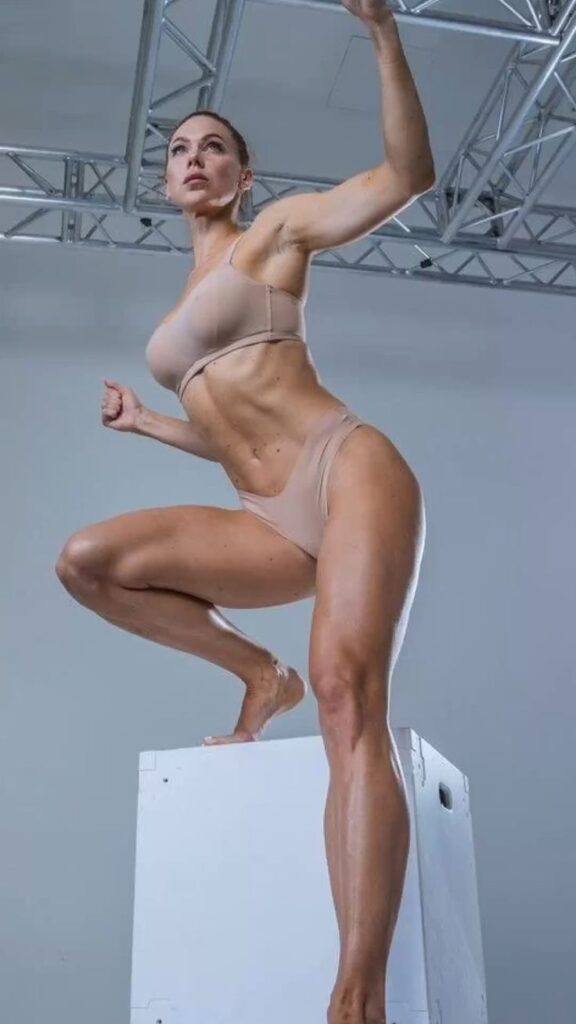

They employ imagination to modify and combine poses, transcending the limitations of their references. This inventive process allows for unique and striking artistic expressions. Feedback plays a crucial role in this iterative process. Peer reviews and self-reflection ensure that the resulting artwork resonates with intended ideas and conveys the desired message or emotion.
The synthesis of searching, imaginatively rethinking, and applying feedback leads to robust artistic growth and a more nuanced representation in one’s art.
Appendix
This section provides curated resources essential for artists seeking various reference poses for their artwork.
Additional Resources and References
- Line of Action: Artists can access a variety of dynamic poses here, designed to improve drawing fluidity and understanding of motion.
- Figure Drawing Reference: This encompasses a vast library of still images showcasing different body types and poses suitable for practice.
- Videos: Instructional videos offer a visual aid for studying the subtleties of human movement and posture.
- Inspiration: Collections of artwork and photography can serve as a creative stimulus for pose composition.
- Thumbnail Photo: An array of thumbnail photos allows for quick visual reference and can aid in angle selection.
- Anatomy Reference Photos: High-quality images provide detailed views of musculature and bone structure, critical for realistic rendering.
- Male and Female Nude Artist’s Model Photos: These photos allow artists to study the human form without clothing, capturing the nuances of light and shadow.
- Multiple Angles: Artists can find images taken from various perspectives to fully understand the dimensionality of the pose.
About the Author
| Name | Alex Taylor |
|---|---|
| Occupation | Art Educator |
| Years of Experience | 15 |
| Specialization | Figure Drawing |
Alex Taylor is a seasoned art educator with a focus on figure drawing and the study of art reference poses. Holding a Master’s degree in Fine Arts, she has dedicated over 15 years to teaching and developing art curricula that aim at improving students’ understanding of human anatomy and dynamic posing. Her authoritative insight is drawn from a rich background working with artists of various skill levels, from beginners to advanced practitioners.
A reputable figure in the art community, Taylor contributes to several art publications and online platforms, sharing her expertise on effective use of references for both traditional and digital artists. Her methodical approach emphasizes the importance of accurate pose replication to enhance illustrative storytelling and character design.
In addition to teaching, Taylor has also participated in numerous art workshops and panels, engaging with communities to advocate for the continued practice of life drawing. She underscores the significance of mastering art reference poses as a foundational skill that bolster artists’ ability to convey motion and emotion within their work.
Notable Contributions:
- Author of “Dynamic Forms: Understanding Human Anatomy in Art”
- Speaker at the International Artist Symposium (2019, 2021)
- Recipient of the ‘Innovative Teaching in Arts’ award (2020)
- 32.1Kshares
- Facebook0
- Pinterest32.1K
- Twitter0
- Reddit0


